Startups at CES 2019: Part One

Every year in early January, our team visits Las Vegas. It is not to lower New Year's proceeds to the casino. While the others are watching striptease and taking selfies with Elvis's doubles, the Madrobots delegation goes over the mountains of gadgets and takes pictures of another little-known hit from Kickstarter. As you understand, this happens at the international consumer technology exhibition CES. This is the sixth CES exhibition for Madrobots, telling what impressed us in 2019.
The exhibition is so big that it takes place in three places in the city center. All major brands are located in the Las Vegas Convention Center (LVCC), known locally as Tech East. Tech West, an exhibition complex of Sands Expo, where startups and small companies have settled, is 30 minutes away. Tech South is an Aria casino resort. There are no gadgets there, but conferences and meetings of marketers, advertisers and representatives of the entertainment industry are taking place.
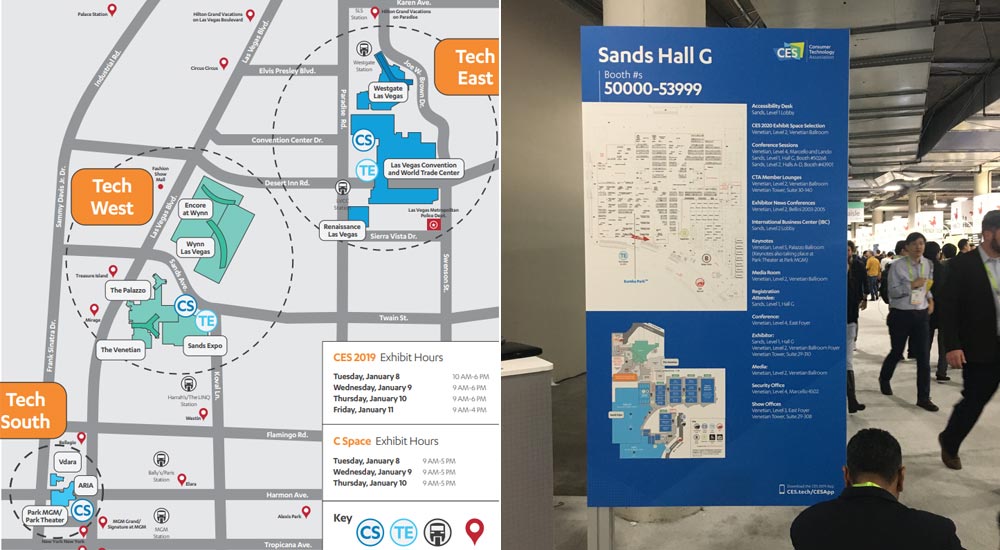
For Madrobots, annual trips to CES serve as one of the sources for replenishing the store’s range with new gadgets. Of greatest interest to us is Sands Expo. On the ground floor of the complex there is a start-up area Eureka Park. The second is divided into thematic areas: health, fitness, childhood, smart home, so there was something to see.
CES demonstrates trends in consumer technology in the coming year. The main trend for 2019 was the absence of the next new “breakthrough” that would have aroused both start-ups and large corporations.
Yes, the strong presence of voice assistants was very obvious. However, the titanic battle of Google with Amazon is not a new trend, but a battle for the interface standard. What will be the main "artificial intelligence" of the future, whose name will become nominal? The Google giant was late for the table, where the Seattle corporation was already well established. Therefore, all means were used: a huge pavilion, stands, dozens of integrations - with Samsung TV, with Sonos, Anker and JBL products. Google Assistant received new features: voice interpreter mode, issuing an electronic boarding pass for the aircraft, automatic placement of punctuation marks during dictation. In his support, even rolled out a "Trojan horse" in the form of Google Maps, where the assistant will be built by default.
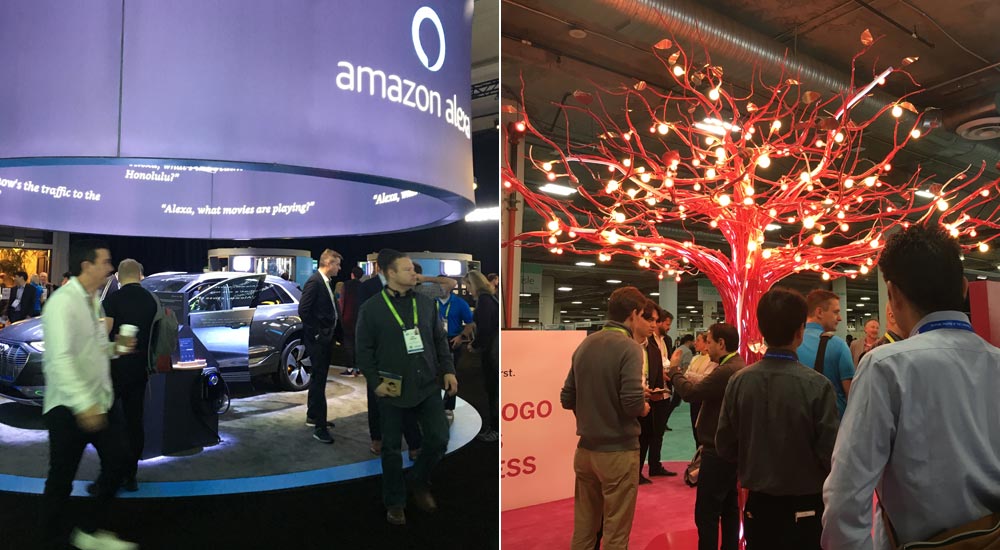
Many CES members remained neutral and decided that it was better to support both platforms simultaneously. For example, releasing products for both one and the second. What is true: Alexa’s Amazon and Google’s assistant can have their own unique capabilities. And there is Siri, a little forgotten Cortana, and no one excludes the emergence of new assistants.
A potential smart gadget for the near future risks being akin to a communal apartment, where many competing "artificial intelligences" live. In practice, Lenovo has already demonstrated the Smart Tab - a kind of cross-smart speaker and tablet. While the tablet is in its dock, it supports Alex. Outside the dock, the Google assistant is turned on. Smart speakers Sonos (One and Beam) also learned to work with both assistants. This is a beta version and it is not known when the final version will reach the consumer. It is noteworthy that you can not use both Alex and Google assistant at the same time: you need to choose one in order not to be confused.
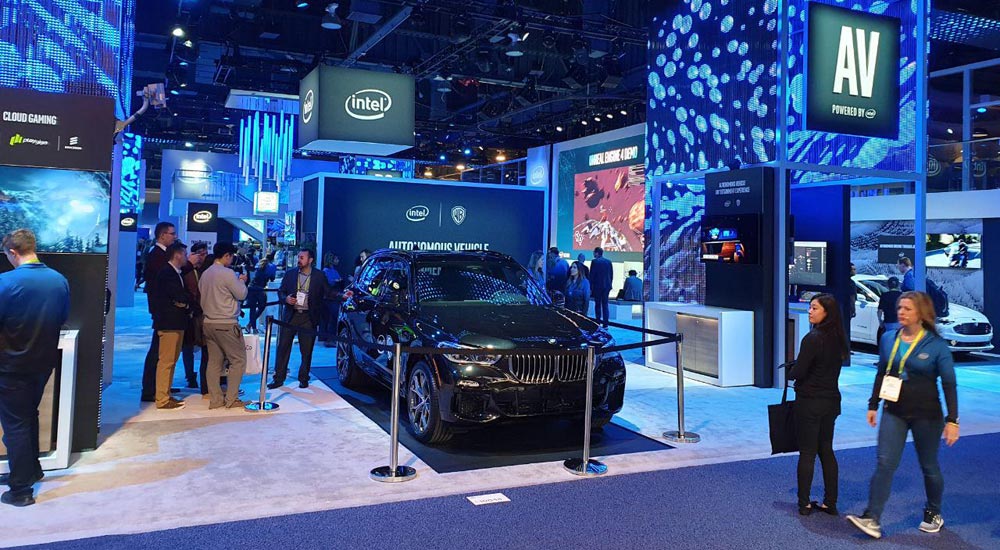
Bright trends of previous years were also present at the exhibition - VR, AR and autonomous machines. Their hour has definitely not come yet: the geeks are disappointed, and the taxi drivers sigh with relief. This is a strange feeling when there are epic presentations and colorful stands, but there is no product. What did we really have?
Smart House
Bloom. Smart umbrella commanded by Alex

Los Angeles-based Shadecraft manufactures and sells automated umbrellas for patios. For CES 2019, she combined a wireless speaker, power bank and a motorized unit. It turned out Bloom - a gadget for turning a "stupid" umbrella into a part of a smart house, managed by assistant Alexa. All in accordance with the latest trends.
The fact is that stationary umbrellas often have a standard design: a winch is mounted in a rack with a handle or without it, which opens and closes the umbrella. Bloom is mounted in the middle of the rack, and then the cable from the umbrella is passed through the hole inside the small winch. The mechanism is simple, but the gadget itself is complex, and is equipped with an anemometer, humidity, light and air quality sensors. When the wind increases, the umbrella will close itself not to fly away. The same command can be given to him at any time through Alex. Weather data is displayed in the Shadecraft mobile app (as without it). Sitting under an umbrella with Bloom installed, you can listen to music via Bluetooth / Wi-Fi and charge your smartphone from the USB port of the device.
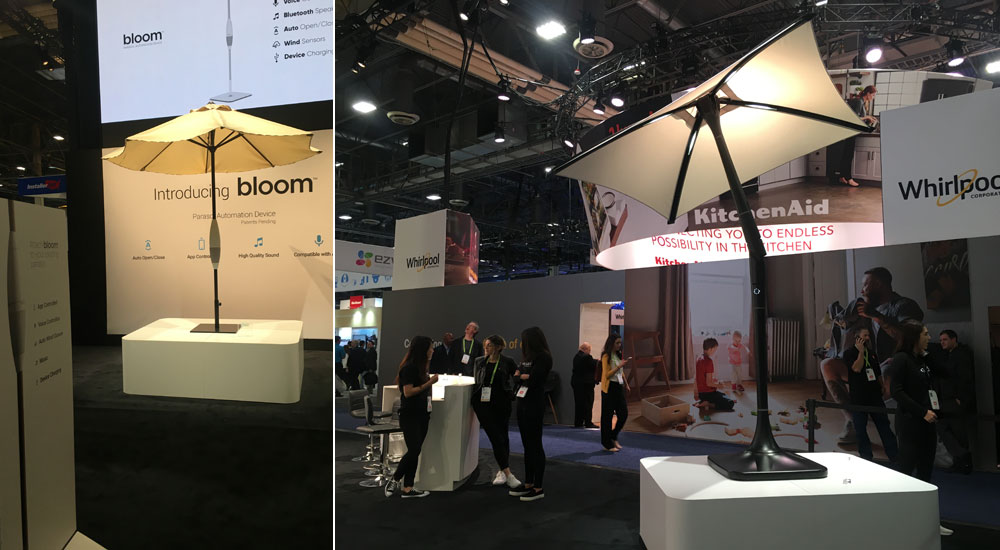
Left - Bloom, Right - Sunflower
A couple of years ago, such a thing would look fancy. In 2019, Bloom is just another element of the landscape. Like many other gadgets in the category of "smart home", it is designed for Western audiences, although it could well be presented on the patio of a domestic cafe. Other Shadecraft products — Sunflower and Blossom umbrellas — have roughly the same features as Bloom, plus built-in solar panels. The Sunflower also turns behind the sun, like a sunflower flower. This way the umbrella gets more solar energy, and effectively shadows the people sitting under it. Here it is, the triumph of human thought.
Nanoleaf Hexagon. LED panels for gamers

Startup Nanoleaf showed at CES 2019 new LED panels. This time - hexagonal, like honeycombs. They have the same functionality as the good old triangular Aurora panels and square Canvas : shimmer with millions of colors, blink to the music, connect to Wi-Fi and smart home, are controlled by voice, without unnecessary torment are attached to the wall. Hexagon touch, like Canvas, that is, they can be controlled by touching the hand (not like a switch on the wall, but, rather, like your smartphone).
Shining hexagons look even more futuristic than previous Nanoleaf models. Target audience - gamers who will surely remember Mass Effect, Halo, “Civilization” and dozens of games, where featured six-sided design appeared. Up to 500 Hexagon panels are attached to one controller at a time.

The Canvas system was also on the stand, but now as a finished product. Speaking of Scotch: Nanoleaf introduced a mounting grid for square panels to be more secure and reliable to fix them to the ceiling and walls. The grille (called Nanoleaf Canvas Mounting Grid) is fixed to the surface with screws, and the socket snaps onto it. Both new products will be available no earlier than the second half of 2019.
Quantum Light / Cololight. A challenger appears!
Since 2013, LifeSmart from Hangzhou has been developing and complementing its own smart home system: hubs, sensors, cameras, switches, light bulbs, LED tape and other small joys of life.
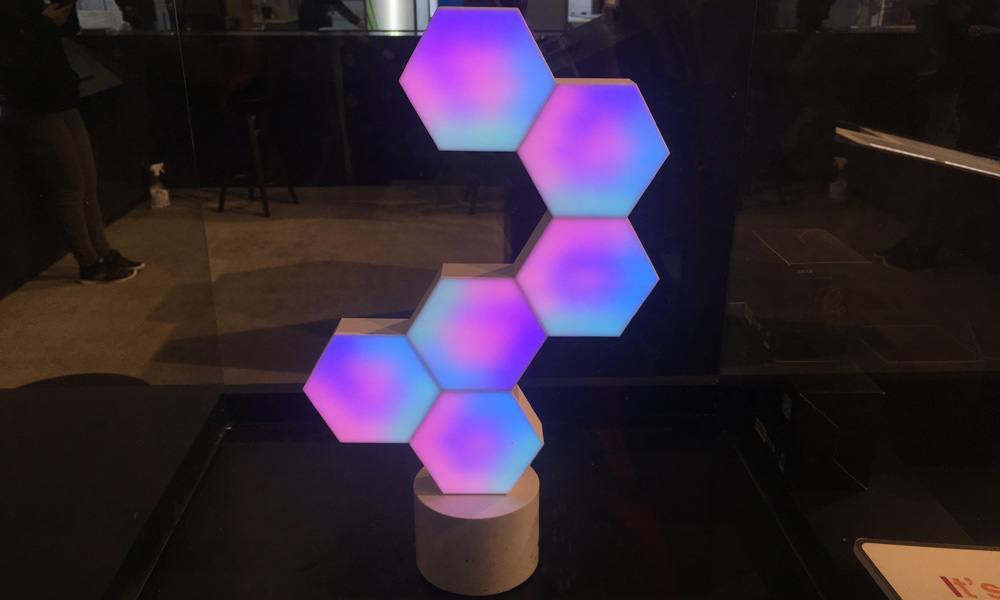
In 2018, the Chinese announced the Quantum Light LED modular illumination. Functionally, it is similar to the Nanoleaf Aurora, but instead of triangles - hexagons, which are assembled in random order. Of these, you can build a luminous panel, or fix them on a stand and collect yourself a desk lamp. Quantum Light connects to Wi-Fi, and is controlled via a mobile application and voice. LifeSmart smart hub is not needed, since the backlight works independently.
Everything was fine until Nanoleaf unexpectedly demonstrated its own hexagons. Nevertheless, Quantum Light backlight won the exhibition's prize in the nomination "Smart Home". Interestingly, the “Chinese Nanolif” immediately has support for light-music effects. With one condition: the application on the smartphone must be active.
During the exhibition, the name Quantum Light was changed to Cololight. The basic set includes three panels (for Nanoleaf - nine), the base and the controller. In China, it costs about $ 118. However, the panels are smaller in size and do not look as impressive as the Nanoleaf panels. They are noticeably inferior to the pioneers.
Smart mirrors
HiSkin. Honestly tells you that you have grown old, have grown stout and it does not matter
Beauty gadgets on previous CES were often meaningless things, like the smart comb L'Oreal. Recall that a microphone was built into it that listened as you comb your hair. This year, it seems, startups have found a common strategy for approaching the topic of beauty, and this is a smart mirror. Such as HiMirror Taiwanese brand HiSkin.
Taiwanese are among the first to pave the way for a new trend. They brought a mirror to Las Vegas regularly since 2017, but in 2019 they had many imitators. The unique original remained about the same as it was: it is a waterproof Android-based tablet with a mirrored surface and an integrated camera. The camera takes a photo of the face, and then the device gives an analysis of the skin condition - the depth of wrinkles, the darkness of the bags under the eyes, the brightness of pigmentation, the appearance of pores and black spots. There are several new versions of the mirror: Mini, Plus and Enterprise (for beauty salons).
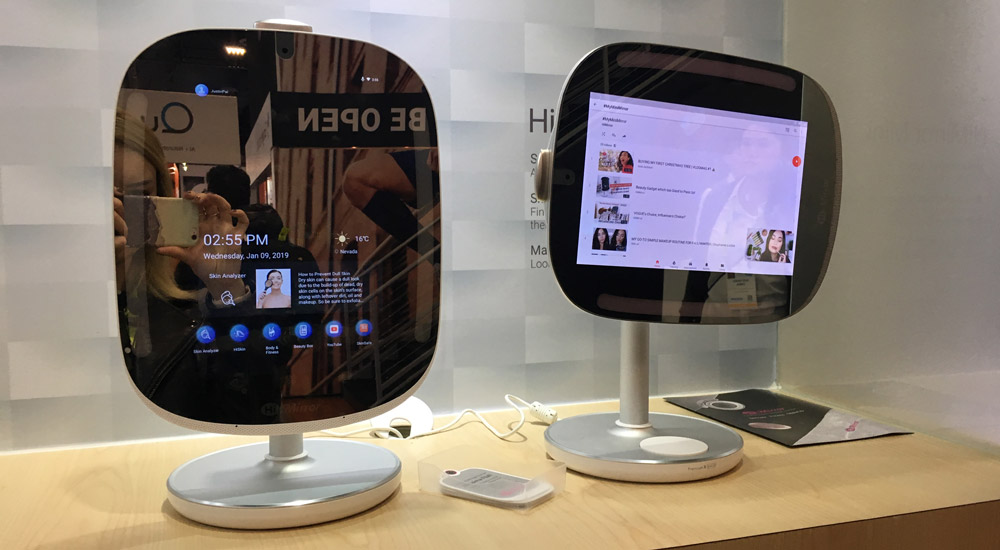
The mirror tracks changes and can say for sure that bags of steel are 0.09% darker than they were, and wrinkles are deeper. The gadget monitors the weather and sends notifications in advance when you need to apply a sunscreen or moisturizer. The capabilities of the mirror allow you to determine the effectiveness of cosmetics: you can save them in the memory of the mirror by scanning a bar code. YouTube is launched on the mirror in order to watch the guides on the make-up and immediately repeat them.
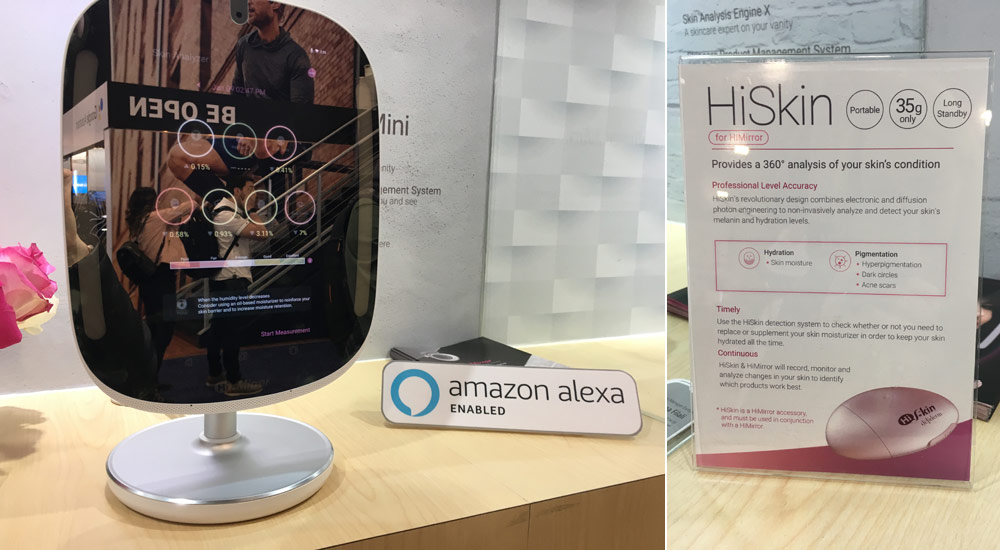
HiSkin mirror on the left, HiSkin skin analyzer on the right
HiSkin Mirror partners are offered a HiSkin skin analyzer, which determines skin moisture and tone, and diagnostic scales with the “original” name Smart Body Scale. With additional accessories, the mirror will not only assess the condition of the skin, but also indicate an excess or lack of weight and fat. There is integration with a virtual assistant Alex. Just like in the fairy tale about Snow White!
Electric Mirror. Expensive and impressive
The company Electric Mirror was born in 1992 in the best traditions of Silicon Valley: in a simple American garage. Its founder, former dentist Jim Michel, made various projects as a hobby, attracted a family to them, then hired workers. Over time, the family business has become a leader in the industry of illuminated, anti-fogging and TV mirrors. Now the company mainly works on the order of hotels and private clients.
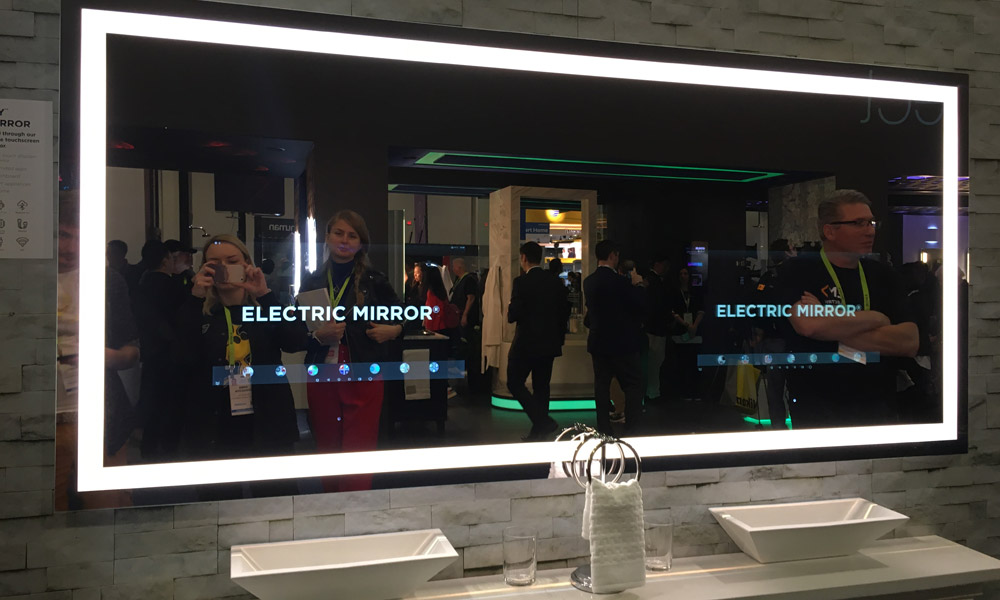
At CES 2019, the company showed its flagship product called Smart Savvy Mirror. This is a huge mirror with an almost invisible touchscreen tablet built into it. The tablet occupies only the middle part of the mirror: its diagonal is 22 inches. But Savvy controls the light, listens to voice commands, and can show useful information: news, places of interest nearby, weather forecasts, and more.
The main use of this mirror is in the hotel. A guest wakes up and goes to brush his teeth, and Savvy immediately shows him the temperature, restaurants and cafes nearby, and hotel services. One click on the anti-fog glass, and champagne is brought to the room. On the same mirror at home, you can watch YouTube or news during morning washing or shaving. Depending on the configuration and size of the mirror, the Electric Mirror will cost $ 2,000–6,000.
There were a lot of other smart mirrors in the startup area. It can be expected that such a device will soon be as often found in the bathrooms of ordinary people, like a water heater and a hairdryer.
Devices for animals
Toletta. Clever tray, saving cats from kidney disease
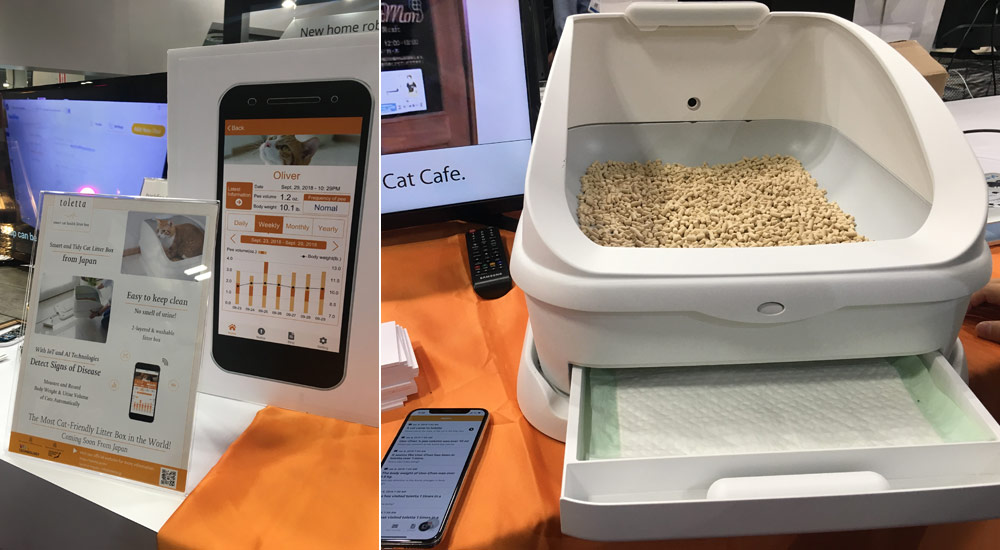
The motto of the Japanese company Hachi Tama - "If the cats become happier, then people too." Its engineers have developed a clever cat tray in full compliance with this phrase. No, the device does not remove itself - this is human happiness. But the sensors and the application determine in advance the symptoms of an approaching chronic kidney disease in the cat so that the owner can show the pet to the veterinarian in the early stages of the disease.
The tray is called Toletta. It consists of two parts - a base with sensors and a removable top with two pallets. An absorbent diaper is placed at the bottom, a filling material is poured into the upper part with a grill. Since the tray was designed for the Japanese market, these are not special consumables, but typical local hygiene products for cats.

A camera is built into the back wall of the tray that recognizes each pet. Toletta weighs the animal, counts the volume absorbed by the diaper and sends the data to the application via Wi-Fi. When the pet goes to the toilet, the owner receives a push-notification on the smartphone. The application analyzes whether the weight has decreased, if the pet urinates too often, and when it identifies an alarming trend, it notifies of the need to enroll in a veterinary clinic. Cats tolerate pain and masterfully hide the symptoms of disease, so a device that sheds light on potential problems can be very useful to many cat owners.
Rawr. For your favorite four-way friend

Ukrainian startups are traditionally active at CES. Rawr, the developers of the clever collar for dogs and large cats - one of the companies representing the country this year.
The eponymous gadget is mainly needed in order to track the movement of a pet by a combination of GPS, Wi-Fi and cellular communication. Rawr is the first smart collar that works on 4G networks. In its application, walks are saved and “security zones” are set up, and if you go beyond that, you can monitor your pet in SOS mode.
Sensors for collar removal as well as ambient temperature and humidity are provided. The latter should, according to the creators, help protect the pet from hypothermia and overheating. A flashlight is built into the front of the collar, increasing the visibility of the animal in the dark. The gadget has its own strap, but the block with electronic "stuffing" is attached to any collar.

There are many options related to animal health in the RAWR app. There is a diary of activities (for planning trips to the vet), tracking activity and calories burned, and pages for entering weight, height, heart rate at rest, breathing frequency at rest and sleep patterns. The startup is about to launch a gadget on Indiegogo in the first quarter of 2019.
Smart gardens
Sinoinnovo. Gardening in the best Chinese traditions

The popularity of horticulture and gardening, including indoor, has grown over 2018. This is indicated by reports from the American research company Garden Research and British retailers Wyevale Garden Centers. Millennial vegans, eco-fanatics, beginner Instagram stars grow their own lettuce for the sake of economy, ecology and likes. The upward global trend has led to the fact that CES 2019 has been forced by “smart pots”.
The Chinese company Sinoinnovo follows this trend. Its main product is FarmBox, a ready-made plant factory. The factory is hydroponic and equipped with sensors, control of irrigation, lighting, temperature and humidity. The entire system can be controlled from a smartphone. But this is a turnkey solution for business, and at CES, Chinese developers showed desktop mini-gardens Ecoships, Ecolady and Ecocube.
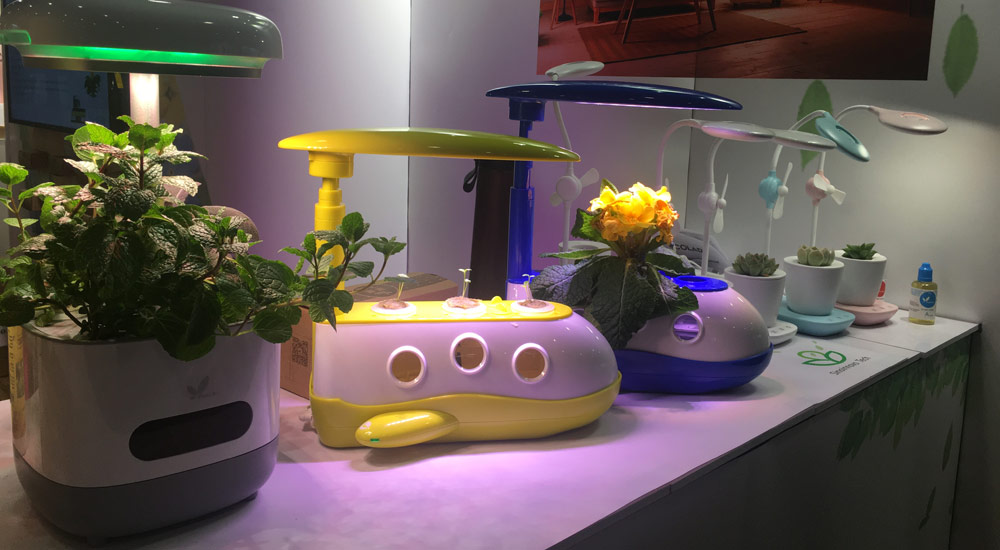
From left to right: Ecocube, Ecoships, Ecolady
Ecoships and Ecolady are illuminated desktop hydroponics, which also works as a reading lamp. Both are striking eccentric Asian design. Especially Ecoships, made in the form of the Ecocube spacecraft, is already more similar to the typical products of the category: minimalistic cube-pot with backlight. All three work in the same way: you plant plants in the substrate, pour water, turn on the lamp. It would seem that the manufacturer of the whole hydroponic "plant" could offer something more interesting, but no. Want smart growing - buy FarmBox.
SeedSheet. Garden-sheet and garden sensors
A few years ago, a simple Vermont boyfriend Cameron McKugler realized that he lacked a vegetable garden in his life. This, in order to collect vegetables for dinner and not waste time on hilling and weeding. From this desire came the Seedsheet project. Seedsheet is literally a “sheet” with the seeds sealed inside. It can be quickly deployed on the ground, watering and getting ready bed, without weeds and pests.
In 2014, the inventor launched a Kickstarter crowdfunding campaign to finance the production of the invention. Gathered a little, only $ 30,000, but since then the startup has been developing successfully. Seedsheet remains roughly the same as before: a piece of material in which seed capsules are sewn at the correct distance from each other. "Sheet" is printed to order, the buyer collects it in the designer on the site.
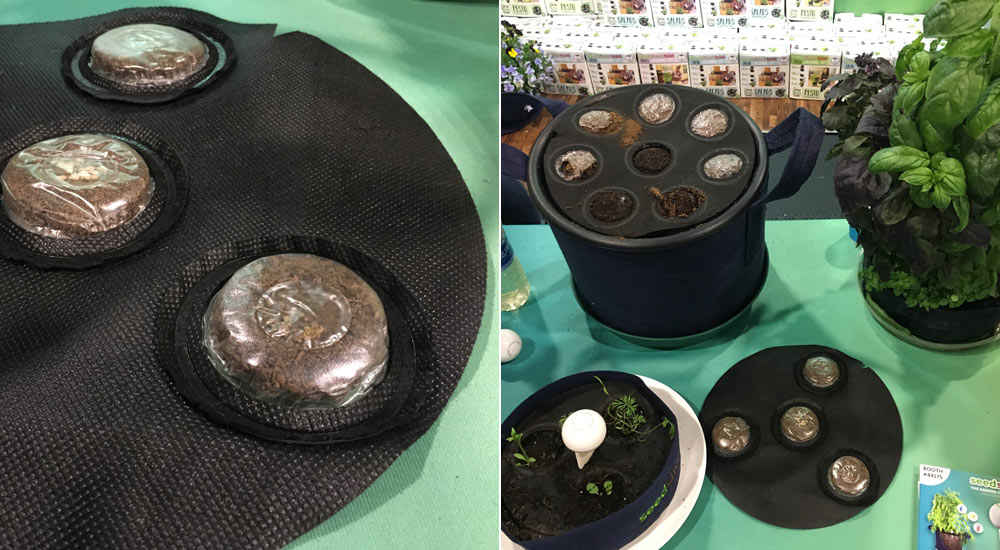
Seedsheet is suitable for a small house or a box on the patio. There were kits for container gardening, which include round "sheets" and a pot of recycled material.
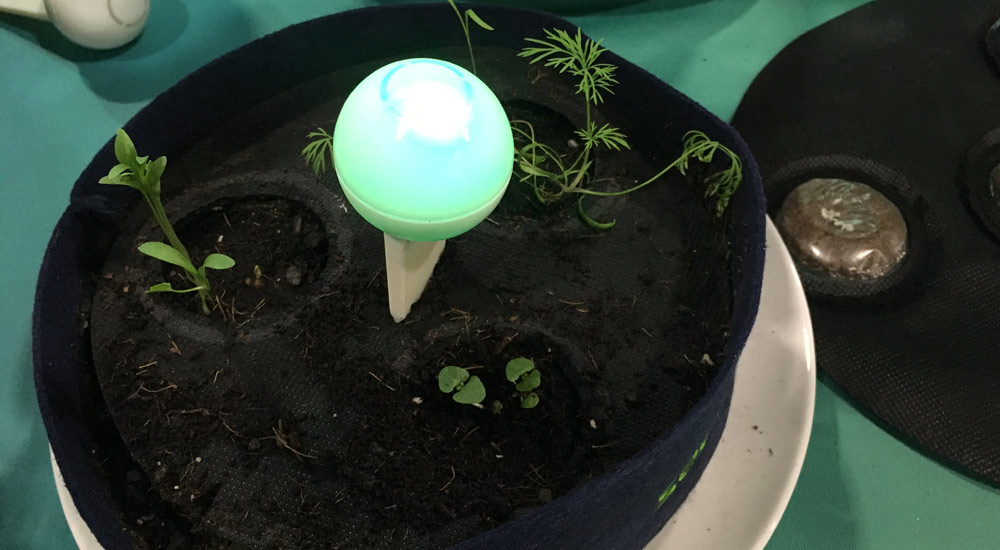
Since CES is an exhibition about technology, not gardening, a startup brought a new product, Garden Guru Sensor. These are three in one: a soil moisture sensor, an ultraviolet sensor and a thermometer that connects to a smartphone via Bluetooth. The application sends notifications that it is necessary to water the garden, monitors the process of seed germination and the weather in the region. Garden sensors have long existed, but only a few have an application and the ability to connect to a smartphone, so innovation is counted.
Veritable. Square-breeding innovation
French startup Veritable launched the first version of its smart garden in 2016. For this, he collected € 114,000 on Kickstarter. There is nothing fantastic and breakthrough in the project, as in the products of Sinonnovo. Gadgets repeats the formula Click and grow: water tank plus lights, plus interchangeable cartridges with soil and seeds. Nevertheless, the mini-version of the gadget called EXKY, which was brought to the exhibition, won an innovation award in the “Technology for a better world” nomination.
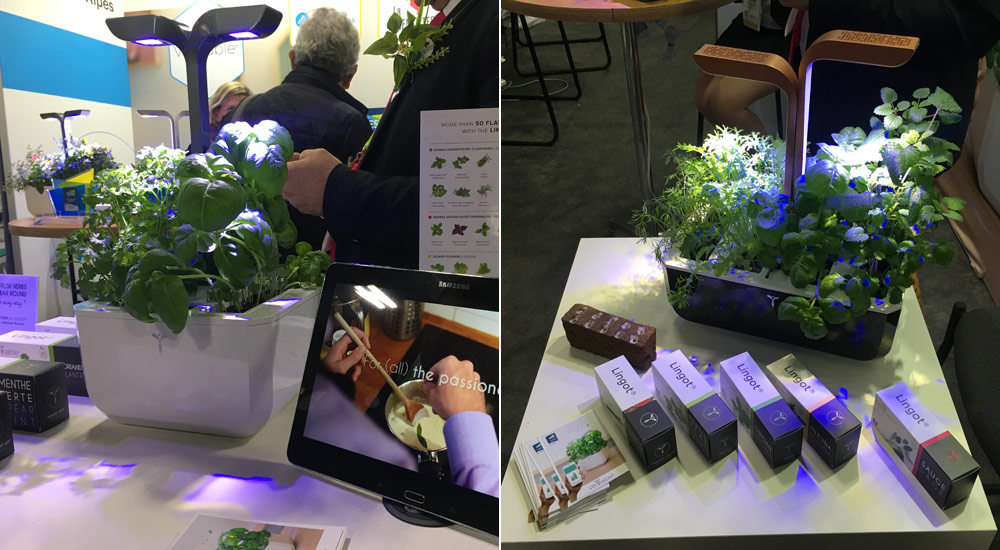
Perhaps the whole thing in an attractive appearance. Thanks to the efforts of industrial designer Chloe Verney, the garden looks futuristic and elegant. The backlight was especially successful - LED bulbs resemble the Veritable logo, two leaves or the letter V. Their height is regulated separately from each other. Since there are two replaceable cartridges with different plants placed in EXKY, it is convenient to raise the backlight to the desired height for both the right and left halves.
Veritable garden connects via Bluetooth to a smartphone on which a proprietary application is installed. Its meaning is only to order replacement cartridges. The application is available only in French and shows a minimum of information about the growth phase of landings. Plus, through the smartphone, you can control the backlight, but it can be done without the application. From the sensors there is a good old "float" with a LED that indicates the need for watering, and a light sensor that regulates the brightness of the backlight and saves energy.
These gardens look nice, but I would really like to see more serious applications in the category of indoor gardening.
Robots
Lovot. Robot as a cure for dislike and loneliness
At all the latest CES shows, companion robots were shown, and 2019 was no exception. The star of the show was the charming robot Lovot. At the same time he looks like a sloth and a pigvin, he cheerfully rolls on the floor on two wheels, curls with affection and asks for pens, flapping “wings”.
Lovot was developed by a Japanese startup Groove X. Its founder, Kaname Hayashi, is called the “father” of the Pepper robot - the same one that works in many Japanese airports, banks and other public places. Pepper can interpret the emotions of people, but Hayashi thought it was not enough.
The problem of existing companion robots is their unnatural behavior. A person does not want to communicate and “be friends” with a device that behaves like a robot vacuum cleaner. In this sense, Lovot is the first “live robot” that behaves as close as possible to a pet or a small child. To this end, the machine is simultaneously equipped with a quad-core processor and a coprocessor. On the head of the robot is an antenna with cameras, microphones and other sensors. The robot processes the incoming information almost without delay and learns on the fly. He remembers which people treat him well, and which people treat him badly, and will run after him and ask for attention, and avoid the second. However, it is unlikely that anyone would want to “kick the baby” on purpose, because its design is designed to please: huge eyes, soft, warm body, cute button-spout.
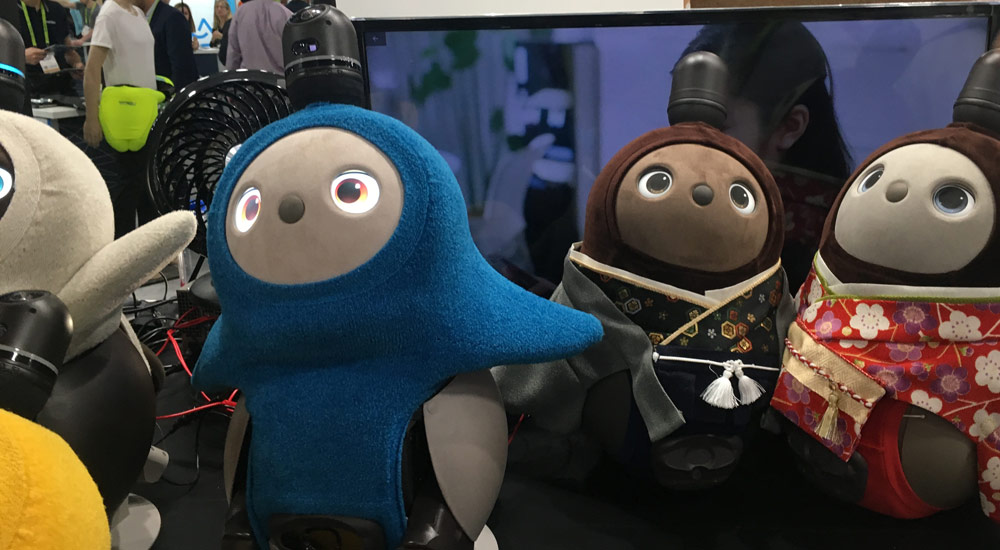
Lovot will definitely not be a panacea for lonely Japanese because of the high price. One robot costs about $ 2,000–3,000, but they are ordered in pairs, rather than one by one. In addition to the function of "being nice and loved," the patrol of the house is included in the functional. Short: the battery lasts for 45 minutes of activity.
Kiki. Robocot, more like a robosobak
California startup Zoetic brought Kiki to the robots show. Unfortunately, from a real cat, the robot has only ears. He behaves like a devoted dog, eager for attention and all the time trying to cajole the owner.
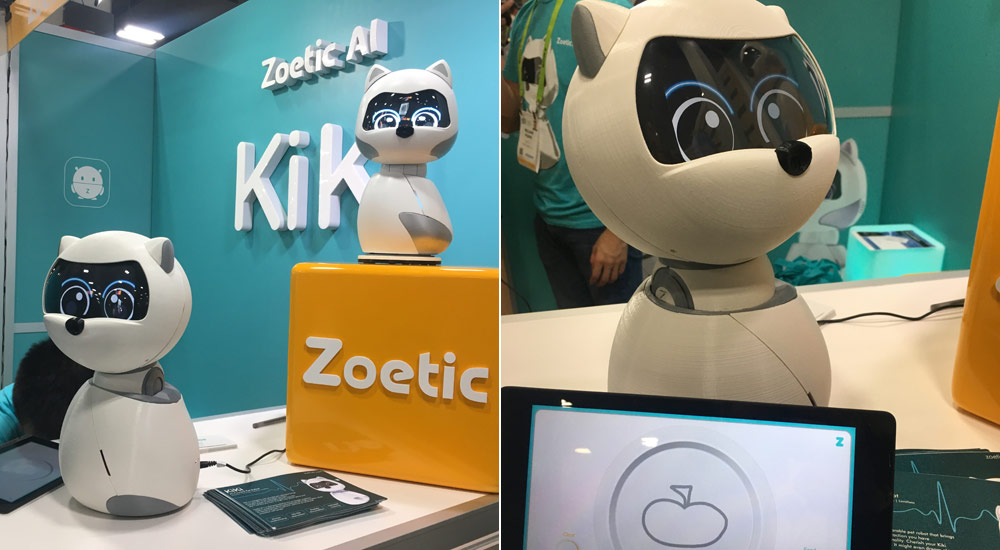
Kiki's body contains 16 tactile sensors, so you can hug and stroke it. Arbitrary sensor developers designate a "preferred." What - is unknown, it must be found empirically. The robot likes it so much when it is stroked with this sensor that it starts dancing. Robokot has no paws or wheels, so he dances just like Eve from the cartoon "WALL-E". The robot is equipped with microphones and turns its head with eyes-display in the direction of the speaker (this is what dogs do more often than cats). “Kiki sees” with his nose, in which a small camera is mounted, and is controlled through an application where a mini-game with robot feeding is available. You need to draw something edible with your finger. If Kiki recognizes the shape of an edible object, he is happy and “eats” it.
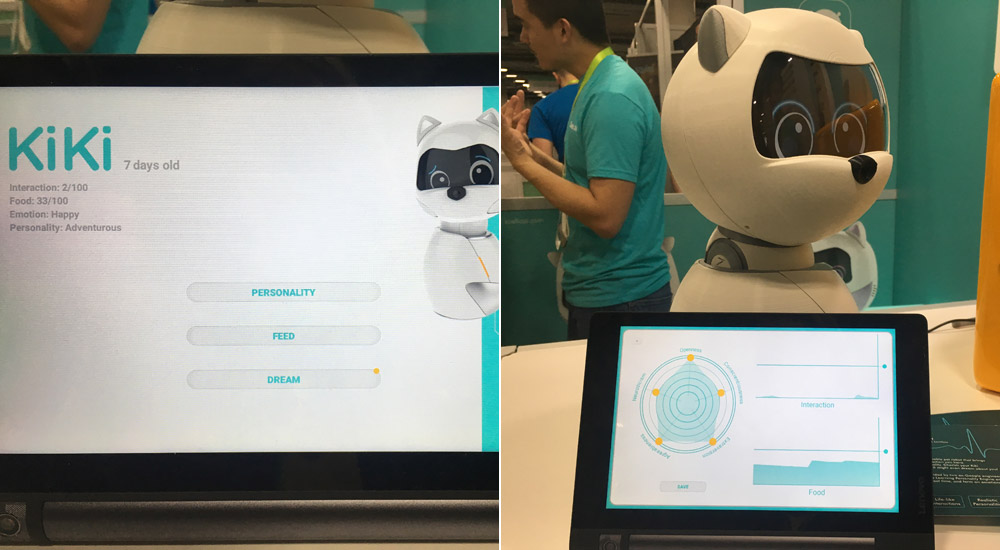
The robot perceives stroking as an approval of its actions, a click on the nose - as a punishment. If you often click on Kiki's nose, he stops doing the action for which he is being punished - unlike an independent cat. With a pet robot, your sneakers are completely safe.
This is only a small part of what we managed to see at CES. The rest will be discussed in the next post.


Only registered users can participate in the survey. Sign in , please.
